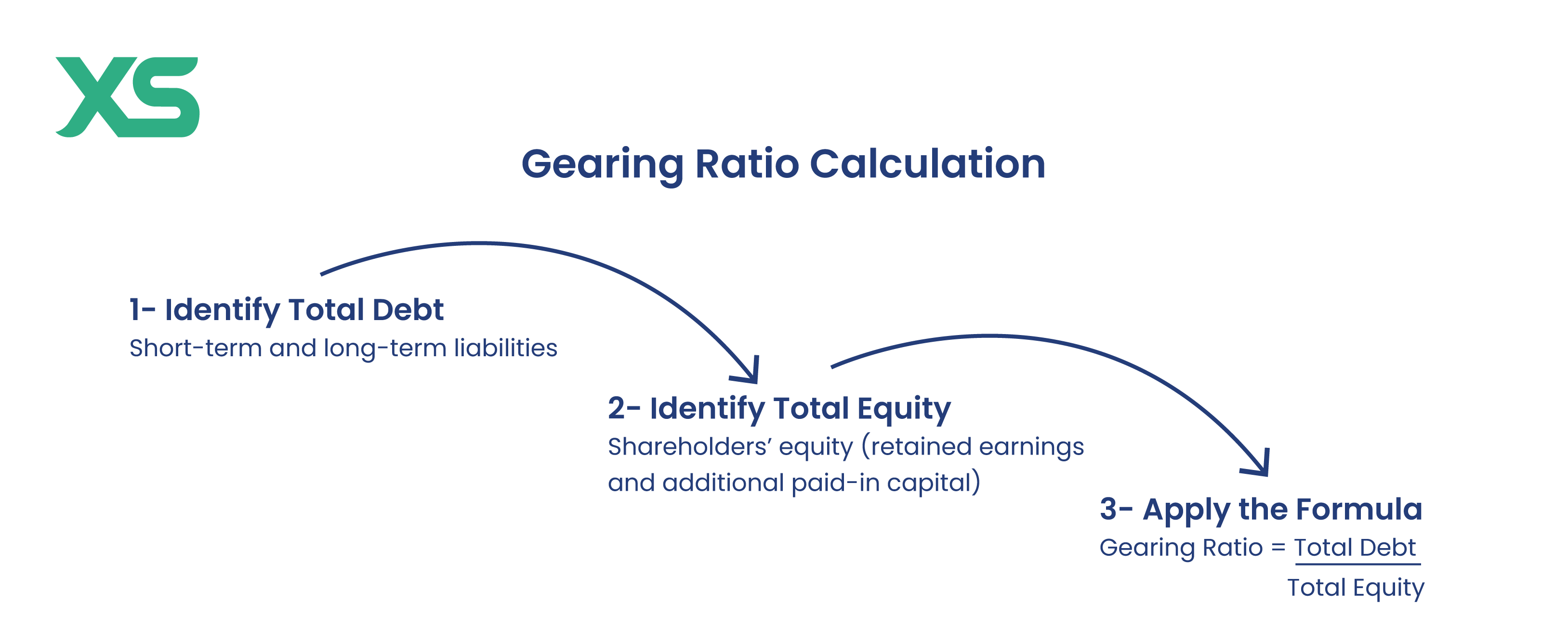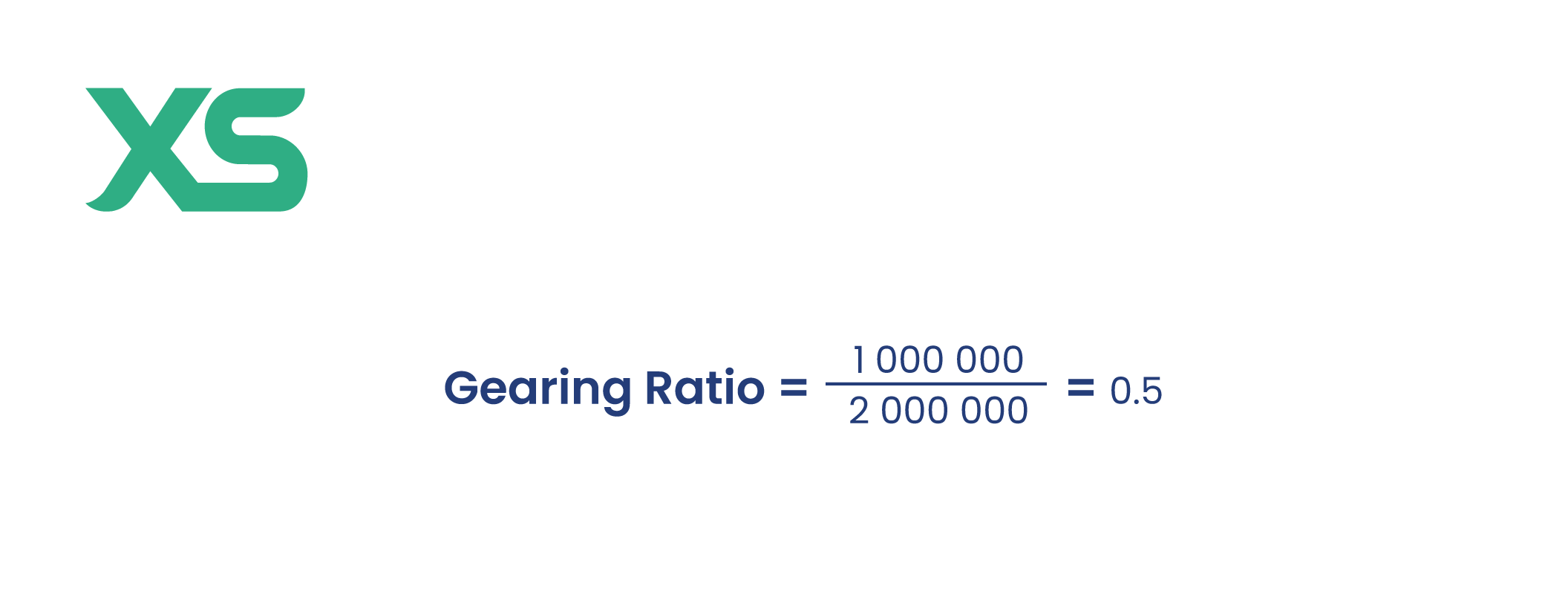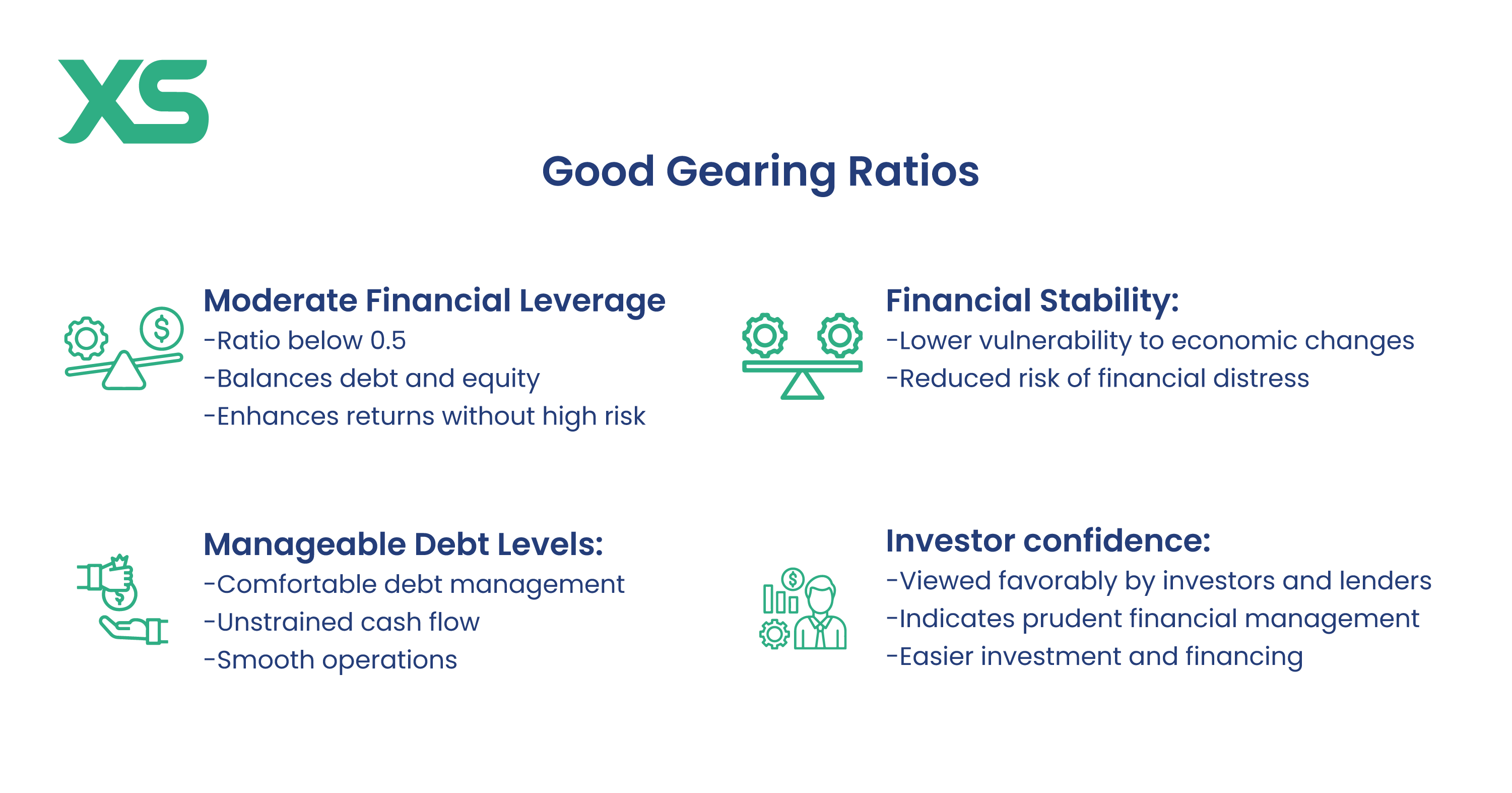Forex
What Is the Gearing Ratio? Definition, Formula, and Analysis
By Nathalie Okde
16 August 2024

Gearing Ratio is a key financial metric that assesses the proportion of a company's borrowed funds to its equity.
This ratio is very important for investors and financial analysts because it offers insights into a company's capital structure and its reliance on debt financing.
This article explores the gearing ratio, how to calculate it, and how to analyze it.
Key takeaways
-
The gearing ratio measures financial leverage by comparing debt to equity.
-
A higher gearing ratio can increase returns and financial risk.
-
A lower gearing ratio indicates a safer, equity-financed structure.
What Is a Gearing Ratio?
The gearing ratio is essentially a measure of financial leverage, indicating how much of a company's operations are funded by debt versus equity.
A higher gearing ratio suggests that a company is more heavily financed by debt, which can increase financial risk but also potentially enhance returns on equity.
On the other hand, a lower gearing ratio indicates a reliance on equity financing, which is typically considered safer but might limit growth potential.
Gearing Ratios Key Terms
Below are some of the terms you must know to understand gearing ratios:
-
Total Debt: Includes all of a company’s short-term and long-term liabilities.
-
Total Equity: Represents shareholders' equity, including retained earnings and additional paid-in capital.
-
Debt-to-Equity Ratio: Measures the proportion of a company's total debt to its total equity. It is a specific type of gearing ratio.
-
Financial Leverage: The use of borrowed funds to increase the potential return on equity.
-
Equity Financing: Raising capital through the sale of shares, representing ownership in the company.
-
Capital Structure: The mix of debt and equity financing a company uses.
-
Debt Servicing: The cash required to cover the repayment of interest and principal on a debt for a particular period.
-
Balance Sheet: A financial statement that summarizes a company's assets, liabilities, and shareholders' equity at a specific point in time.
-
Financial Risk: The risk that a company will not be able to meet its financial obligations due to high levels of debt.
How to Calculate Gearing Ratio
Calculating the gearing ratio involves comparing the company’s debt to its equity. There are several methods to calculate it, but the most common is the debt-to-equity ratio.

Here are the steps:
-
Identify Total Debt: This includes both short-term and long-term liabilities.
-
Identify Total Equity: This is the shareholders' equity, which includes retained earnings and additional paid-in capital.
-
Apply the Formula: Divide total debt by total equity to get the gearing ratio.
Gearing Ratio Formula
The gearing ratio formula is straightforward:

For instance, if a company has $1,000,000 in total debt and $2,000,000 in total equity, the gearing ratio would be:

This means the company has $0.50 of debt for every dollar of equity.
Gearing Ratio Interpretation
Gearing ratio analysis is an essential part of financial assessment. It provides insight into a company's use of debt versus equity in its capital structure and helps stakeholders understand the financial leverage and risk associated with the company.
Understanding what constitutes a good or bad gearing ratio is crucial for assessing a company's financial health and risk profile.
However, it is important to note that the definition of good and bad gearing ratios can vary significantly depending on the industry, economic environment, and specific company circumstances.
Good Gearing Ratios
A good gearing ratio indicates a balanced approach to leveraging debt and equity, providing the company with financial flexibility and stability.
Typically, a good gearing ratio is below 0.5, meaning the company has less debt than equity.

Here are some detailed characteristics of good gearing ratios:
Moderate Financial Leverage: A ratio below 0.5 suggests that the company is using a moderate amount of debt. This balance helps to increase returns on equity without exposing the company to excessive financial risk.
Manageable Debt Levels: Companies with good gearing ratios can comfortably manage their debt obligations. Interest payments and principal repayments do not strain the company’s cash flow, allowing for smoother operations.
Financial Stability: A lower gearing ratio indicates financial stability. The company is less vulnerable to economic downturns and interest rate hikes, reducing the risk of financial distress.
Investor Confidence: Investors and lenders often view companies with good gearing ratios favorably. It suggests prudent financial management and lowers the perceived risk, making it easier for the company to attract investment and secure financing at favorable terms.
Bad Gearing Ratios
A bad gearing ratio indicates an over-reliance on debt, exposing the company to higher financial risk and potential instability. Typically, a gearing ratio above 1 is considered high and potentially problematic.
Here are some detailed characteristics of bad gearing ratios:
High Financial Leverage: A ratio above 1 means the company has more debt than equity. This high leverage can increase returns during good times but also significantly increase financial risk during downturns.
Strained Cash Flow: Companies with high gearing ratios face substantial interest payments and debt servicing costs. This can strain cash flow, especially if revenue growth does not keep pace with debt obligations.
Increased Financial Risk: High gearing ratios indicate greater financial risk. The company is more vulnerable to economic fluctuations, interest rate increases, and changes in market conditions, which can lead to financial distress.
Limited Financing Options: High leverage can limit a company’s ability to obtain additional financing. Lenders may be reluctant to extend more credit, or if they do, it might come at a higher cost due to the increased risk.
Potential for Insolvency: In extreme cases, a very high gearing ratio can lead to insolvency if the company is unable to meet its debt obligations.
Contextual Considerations
When determining whether a gearing ratio is good or bad, it is essential to consider the context:
-
Industry Norms: Different industries have different benchmarks for gearing ratios.
Utility companies often operate with higher gearing ratios due to their stable cash flows, whereas technology companies might maintain lower ratios due to more volatile earnings. -
Economic Environment: The broader economic context can influence the assessment of gearing ratios.
Higher gearing might be more sustainable in a low-interest-rate environment, whereas high interest rates can make high leverage more risky. -
Company Life Cycle: The stage of a company’s life cycle matters. Start-ups and high-growth companies might have higher gearing ratios as they invest in expansion.
However, mature companies might have lower ratios to maintain stability and return value to shareholders. -
Management Strategy: The company’s strategic goals and risk tolerance are crucial.
Some companies might deliberately choose higher gearing to pursue aggressive growth strategies, while others prefer a conservative approach to ensure long-term stability.
Comparing Gearing Ratios with Other Financial Ratios
Gearing ratios are crucial for understanding a company's financial leverage, but it's important to compare them with other financial ratios to get a comprehensive view of a company's financial health.
Here are some key comparisons:
Gearing Ratio vs Leverage Ratio
The gearing ratio and leverage ratio are often used interchangeably but have distinct focuses:
Gearing Ratio:
-
Measures the proportion of a company's debt to its equity.
-
Formula: Gearing Ratio = Total Debt / Total Equity
-
Focuses on the balance between borrowed funds and equity financing.
Leverage Ratio:
-
A broader term that includes various measures of financial leverage.
-
Common leverage ratios include debt-to-equity, debt-to-assets, and interest coverage ratio.
-
Provides multiple perspectives on how much debt a company uses to finance its operations.
Gearing Ratio vs. Debt Ratio
While both ratios assess a company's use of debt, they serve different purposes:
Gearing Ratio:
-
Specifically measures the ratio of total debt to total equity.
-
Indicates the degree of financial leverage and reliance on debt financing.
Debt Ratio:
-
Measures the proportion of a company’s total assets that are financed by debt.
-
Formula: Debt Ratio = Total Assets/Total Debt
-
Provides insight into the overall level of debt relative to the company’s asset base.
By comparing the gearing ratio with other financial ratios, stakeholders can gain a more nuanced understanding of a company's financial health and risk profile.
This comprehensive analysis helps make informed decisions about investing, lending, and strategic planning.
Pros and Cons of Gearing Ratios
Gearing ratios have their own benefits as well as limitations.
Pros
-
The gearing ratio provides a straightforward measure of how much a company relies on debt versus equity.
-
It helps assess the financial risk associated with a company’s capital structure.
-
Useful for comparing companies within the same industry to understand their leverage levels.
Cons
-
Different industries have different benchmarks for what constitutes a good or bad gearing ratio, making cross-industry comparisons misleading.
-
The gearing ratio should be considered alongside other financial metrics, such as the interest coverage ratio and cash flow, for a comprehensive analysis.
-
High gearing is not always negative if the company can manage its debt effectively and generate sufficient returns on its borrowed funds.
Conclusion
The gearing ratio is a vital tool for assessing a company’s financial health. By understanding and analyzing this ratio, stakeholders can make informed decisions about investing, lending, and managing businesses.
It highlights the balance between debt and equity financing and helps gauge the financial risk associated with a company’s capital structure. Join XS for further tips and guidance in your trading journey!
FAQs
What Is the Gearing Ratio Formula?
The gearing ratio formula is a straightforward way to measure a company's financial leverage. The most commonly used formula is the debt-to-equity ratio, which is calculated as follows: Total Debt / Total Equity.
In this formula, "Total Debt" includes all of a company's short-term and long-term liabilities, while "Total Equity" represents the shareholders' equity.
What Gearing Ratio is Good?
A gearing ratio below 0.5 is generally considered good, indicating a balanced and lower-risk capital structure. This suggests that the company is not overly reliant on debt and has a stable equity base to support its operations.
What Does a Gearing Ratio of 0.5 Mean?
A gearing ratio of 0.5 means that the company has $0.50 of debt for every dollar of equity, suggesting moderate financial leverage. This balance indicates that the company uses debt responsibly to finance its operations without taking on excessive financial risk.
What If the Gearing Ratio is High?
A high gearing ratio means higher financial leverage and risk. Companies with high gearing ratios must manage their debt carefully to avoid financial distress.
High leverage can increase returns during good times but significantly increases financial risk during downturns, making the company more vulnerable to economic fluctuations and interest rate increases.



